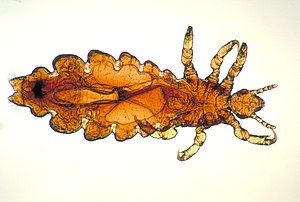Pediculosis
| Pediculosis | |
|---|---|
 |
|
| Pediculus humanus capitis (♀) | |
| Classification and external resources | |
| Specialty | infectious disease |
| ICD-10 | B85.0 |
| ICD-9-CM | 132.0 |
| DiseasesDB | 9725 |
| MedlinePlus | 000840 |
| eMedicine | med/1769 |
| MeSH | D010373 |
Pediculosis is an infestation of lice (blood-feeding ectoparasitic insects of the order Phthiraptera). The condition can occur in almost any species of warm-blooded animal (i.e. mammals and birds), including humans. Although pediculosis in humans may properly refer to lice infestation of any part of the body, the term is sometimes used loosely to refer to pediculosis capitis, the infestation of the human head with the specific head louse.
Pediculosis may be divided into the following types:
Head-lice infestation is most frequent on children aged 3–10 and their families. Approximately 3% of school children in the United States contract head lice. Females are more frequently infested than males. Those of African descent rarely suffer infestation due to differences in hair texture.
Head lice are spread through direct head-to-head contact with an infested person. From each egg or "nit" may hatch one nymph that will grow and develop to the adult louse. Lice feed on blood once or more often each day by piercing the skin with their tiny needle-like mouthparts. While feeding they excrete saliva, which irritates the skin and causes itching. Lice cannot burrow into the skin.
To diagnose infestation, the entire scalp should be combed thoroughly with a louse comb and the teeth of the comb should be examined for the presence of living lice after each time the comb passes through the hair. The use of a louse comb is the most effective way to detect living lice.
The most characteristic symptom of infestation is pruritus (itching) on the head which normally intensifies 3 to 4 weeks after the initial infestation. The bite reaction is very mild and it can be rarely seen between the hairs. Excessive scratching of the infested areas can cause sores, which may become infected.
The number of diagnosed cases of human louse infestations (or pediculosis) has increased worldwide since the mid-1960s, reaching hundreds of millions annually. There is no product or method which assures 100% destruction of the eggs and hatched lice after a single treatment. However, there are a number of treatment methods that can be employed with varying degrees of success. These methods include chemical treatments, natural products, combs, shaving, hot air, silicone-based lotions, and ethanol (ethyl alcohol). The pharmacological treatment of pediculosis include the use of crotamiton applied twice at 24 hour interval and washed off day after that. Benzyl benzoate also can be used when combined with lindane, it is applied once and then washed off after 24 hours.
...
Wikipedia
